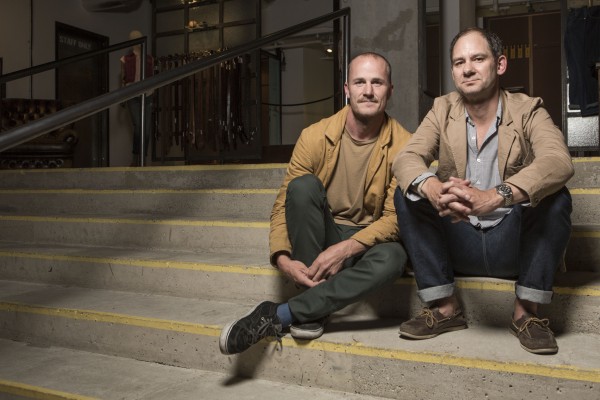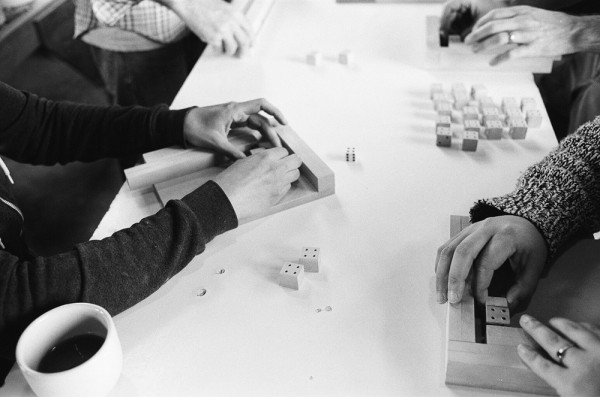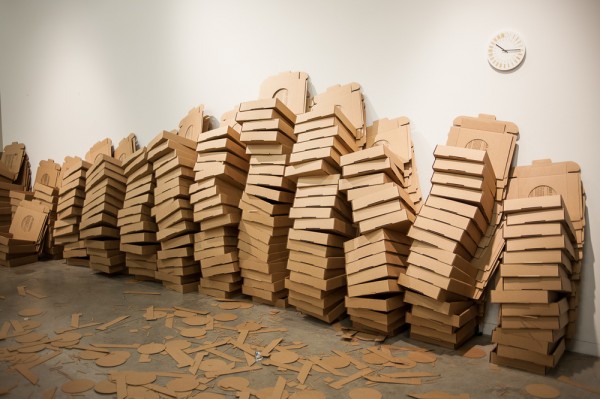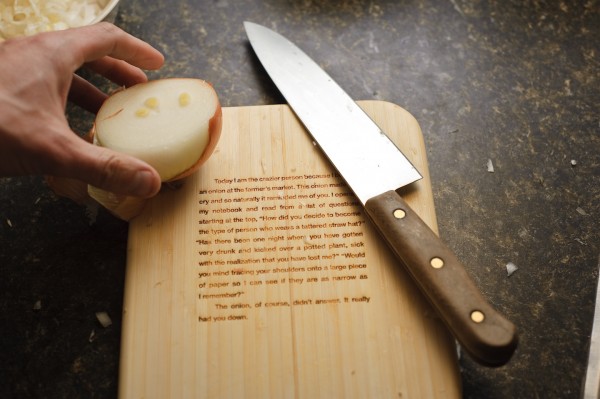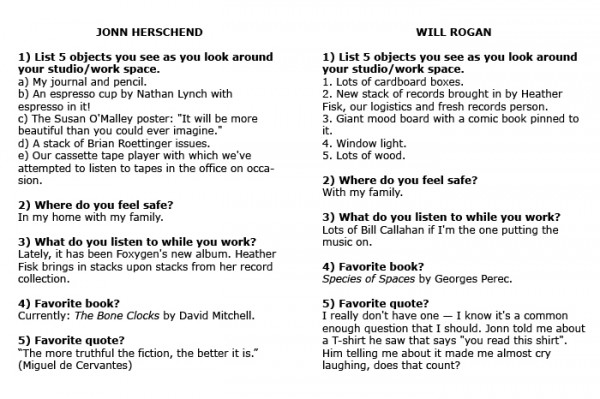Objects Sublimated to Things
The Thing, founded and run by artists Jonn Herschend and Will Rogan, is “is a periodical in the form of an object. It’s like a magazine, except that each issue is conceived of by a different contributor and then published on a useful object.” Four times per year, subscribers receive an iteration of the journal. Over the years those objects have included an LP in collaboration with Rodarte; a self-referential pillow case with John Baldessari; an epistolary shower curtain with Dave Eggers; and a 24-hour wall clock with Tauba Auerbach.
unexpected projects is a collaboration between Jenny Salomon and Jen Stager. In this series, they interview other collaborative teams in the Bay Area to find out what their projects and processes are all about.
In Conversation: Jonn Herschend and Will Rogan of The Thing Quarterly
The Thing, founded and run by artists Jonn Herschend and Will Rogan, is “a periodical in the form of an object. It’s like a magazine, except that each issue is conceived of by a different contributor and then published on a useful object.” Four times per year, subscribers receive an iteration of the journal. Over the years those objects have included an LP in collaboration with Rodarte; a self-referential pillow case with John Baldessari; an epistolary shower curtain with Dave Eggers; and a 24-hour wall clock with Tauba Auerbach.
The Thing is not only a collaboration between Jonn and Will and the team they’ve brought together in their office, but also a collaboration with the many artists they invite for each particular production. Some issues involve explicit collaborations in their conception, while others are conceived primarily by one person, but executed by many.
The Thing marries text and object, making art with a function that moves through the world.
unexpected projects: How did you first decide to work together?
Will Rogan: We started by wanting to collaborate with each other. We were both at Berkeley. We started at the same time. We both had families. We gravitated towards each other because we were fathers and maybe older [than the other students] in the program. And we liked each other’s work.
We were interested in objects in one way or another: objects sublimated into other things. Jonn through his paintings; me through photographs. And we were both trying to put language into our work at the time. At first we were talking about making a newspaper; we were interested in the history of publications in the Bay Area. Rolling Stone and Art Forum both started here.
Jonn Herschend: I’ll also jump in and say that Will was a librarian at SFAI for five years, and I was a high school English Lit teacher for five years, so we both had an interest in libraries and books.
WR: And both of those jobs were about sharing information.
JH: We talked, and talked, and talked about it. We kept talking about the collaboration, what it would be; we graduated and kept talking. Finally, Courtney Fink at Southern Exposure said, “just do a residency and quit talking about it.” We thought it might be a project that we’d do for a year, and we made all of the objects by hand. That was in 2007.
UP: What is the breakdown of your collaboration? Who does what? How do you decide which other artists to collaborate with?
JH: In the beginning, Will and I would have conversations about people we loved and wanted to work with and that was it. George Saunders kept coming up. Even today, we’re still emailing him and asking him to participate. The Thing has changed a lot over the years; now we have a team including Heather Fisk, Sarah Simon, Jenna Jorgensen and Kati Mooney and other people are involved in the discussions.
WR: When did we hire our first employee?
JH: Three or four years ago; 2010, I think. We got serious! Actually we didn’t get serious even then. We didn’t get serious until we hired Sarah. She brought game face.
UP: Is The Thing a non-profit or for-profit?
JH: We’re not necessarily for-profit. We’re not opposed to profit.
WR: We are in favor of profit!
JR: When we started out we discovered that the easiest thing to do in America is to start a business and the hardest thing to do in America is to start a non-profit. Everything is against you; you have to have serious cash to become a non-profit.
UP: While we are talking about profit, how do you decide all the pricing for subscription fees and everything else?
WR: In the beginning, Jonn and I were like, “what would you pay?” And then we’d go back and forth: “I don’t know, that seems a little much and I definitely don’t want to pay for shipping!” Shipping’s tricky: that’s added cost. It has constantly been a negotiation; we filter the cost of the subscription through what we feel would be reasonable in our lives. The Thing is about accessibility in a way. We’re not starting an edition house of objects. We want to find a way to be more accessible, so we start with the place that we know: “What can we afford; what would we do?”
JH: We have to learn to make each new object, so we have to figure out the manufacturing technique for every new issue, which is insane. Anyone running a business, what they do is figure out how to manufacture one thing and they crank it out. We’re the opposite.
UP: Do you ever have to tell an artist that something is too difficult?
JH: Allora & Calzadilla had an amazing proposal for a trashcan: you would throw something away and it would throw it back at you. And we were like “YES!” but we couldn’t figure out how to make it, and the can probably would have been out of our price range. As much as possible, we try to figure out how to make what artists propose. Will had to figure out how to make a boomerang.
WR: The boomerang was easy! It’s really fun when an object comes up and you think, “I know exactly how to make this!”
UP: Can you think of the most rewarding experience and/or the biggest disaster?
WR: We have a disaster story but it doesn’t have to do with working with the artists; it has to do with the decisions that we made. We were going to New York to do two art fairs: The Printed Matter Art Fair and the Editions Artists Book Fair. We decided to do a wrapping party as an event. Wrapping parties (wrapping the objects for the current issue) require a lot of enthusiastic hands in the room. We shipped a ton of stuff (the packing materials) to New York, way too much stuff. The shipping cost is what killed us. We shipped it there and we had to ship it all back. It was just a financial debacle.
Not only that, but New Yorkers are busy; they have shit to do and they are not going to stop and help out this California conceptual art publication. We thought we were going to meet lots of people in New York who’d come wrap The Thing with us, but it turned into our friend DJing, with John and I and one other person trying to wrap a thousand issues. I remember sweating. I was pushing around heaps of boxes into a back room. And just sweat everywhere.
JH: In San Francisco, the wrapping party has become part of our model. It’s actually cheaper for us to hire a bunch of students to come in and wrap the issues, but it’s more celebratory to have a party. Every time we have a wrapping party in San Francisco, it’s a packed house. People really want to help and wrap stuff up and drink beer and eat pizza and it is a total blast. We are always amazed.
UP: And a memorable positive experience?
JH: I have a favorite thing that we do. We had a really good year two years ago and we went out and had a big dinner with everyone. It was just fun to be with everyone and celebrate.
WR: That is something I hadn’t anticipated ever being, the person hosting celebratory dinners. It felt great.
UP: How long have you had your space in the Tenderloin?
JH: A year and a half. Moving to the Tenderloin has been great; we have a huge space, which is amazing. We really thought when we lost our last lease (in the Mission), there was just nowhere in the city to go, but then you discover that there are places all over. I’m thrilled to be in the Tenderloin, it reminds me of the Mission in 1998. I think there are a lot of examples of resilience in the art scene: Bob Linder and Jonathan Runcio at Capital over in Chinatown, Et Al. gallery in Chinatown, and Andrew McClintock with Ever Gold; so there is a lot of possibility.
UP: Does your collaborative practice feed back into your individual practices?
WR: We keep those two activities separate — our personal creative activity and our collaborate creative activity; they both come out of us, so our voices are in there but we tend to keep our creative pursuits outside of this separate. That said, there is always [a] back and forth for me. I got interested in packaging in my studio, and I’m sure that comes from The Thing. It is probably hard for us to see it, but I‘m sure that we bring certain things from our studio practice in here to our work with The Thing.
JH: One of the ongoing dilemmas we have is how do you make art and make it appealing to a large segment of the population, because right now visual art in general is relegated mostly to a very small segment of the population. That is one of the things that The Thing is all about. And I do think about that in my own work. I also think about comedy, which is a great delivery vehicle for smuggling your art ideals into your work. Also, through my dealings with the artists we work with, who are all insanely professional, I’ve learned that professionalism makes a huge difference. So when I work with a curator now (for my personal projects) I am on it. I think that is something that is not necessarily part of the art making, but it is part of the working relationship, which is so important.
UP: Are your kids involved with your work with The Thing?
JH: Now that they are older, not explicitly. I mean, it’s what we do, and I hope that when they are adults they will look back and think, “we were in San Francisco and there was this great art scene and our parents were a part of it.” My parents ran an amusement park and now I can see that was really cool, but when I was younger, I was really embarrassed.
Also, objects from different issues are integrated into our lives. We use the Starlee Kine cutting board [“Crying Instructions”] that we made for Issue 10 and I doubt that my kids think, “there’s that cutting board from The Thing Quarterly” every time they use it, but it is present in their daily lives.
UP: Is there a political factor/filter in The Thing?
JH: I think that there is a politics to what we do. When I go through customs in other countries, they ask “What is your profession?” And I say “I am an artist.” They say, “oh, well, what are you working on?” I say, “I’m here for a show”.
And then when I come back into the US, every time I say, “I’m an artist,” they say, “but what’s your job?” Elsewhere, being an artist is actually a legitimate profession; here it is absolutely not.
WR: You see it on every level. You see it in politics, in the lack of support from the government.
JH: And that attitude is “What does it bring to the bottom line? What does art contribute to our dollars?” Creative Capital talks about what the art tourist spends when they go to New York verses the sports tourist. It is astronomical how much more money the art tourist brings in to a city.
Neither of us is overtly political in our individual work, but I feel like just being an artist in the United States is a political act. Will said something years ago and I thought it was really great. After Bush won his second presidency and everything was (framed as) black and white — “this guy is good, Saddam is bad…” Will said, “I just want to make stuff in the gray area.” I think that is where art operates in general. Pushing art out into a larger audience is a political stance. We want to make art more a part of the general conversation.
